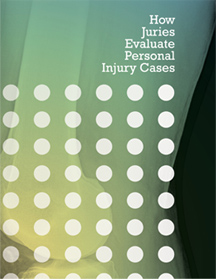One approach used by personal injury attorneys to set the initial demand figure
Here is one approach used by personal injury attorneys to figure out how much money to demand initially from the insurance carrier to settle a personal injury claim.
1. Medical bill assessment
The injury attorney begins with an evaluation of the well-documented medical bills. If the injury can be objectively proven such as a broken leg, cartilage damage in a knee, or shoulder injury that required arthroscopic surgery, the attorney can multiply the total medical bills by a factor of two, three, four, or five depending upon the length of time the injury took to heal, the quality of the medical documentation, and whether or not the particular area of the body was totally symptom-free prior to the injury. A previous injury to the same area of the body reduces the multiplication factor. If the injury resolved completely in a period of two months with no residual problems, the attorney may use a low figure such as two or three times the medical bills. If the injury took a substantial period of time to resolve, such as a year or more or required a medical procedure, the attorney may use a higher figure such as four or five times the medical bills. The figure arrived at is used as the first tangible value.
2. Lost income assessment
The next step the attorney undertakes is a determination of the actual loss of income resulting from the injury. The lost income must be well-documented so it cannot be successfully attacked or tested at trial. The best documentation is the simple calculation of several weeks lost time at a certain rate of pay per week. The worst is an estimate of self-employment income lost with little supporting documentation such as tax returns, an accountant’s letter, or other similar proof. If the loss is well-documented, reasonable, and consistent with medical reports, the attorney may multiply the total by two, three, or four depending upon the quality of the documentation and the length of time for recovery. This is the second tangible evaluation figure and is added to the medical bill figure described in number l above.
3. Assessment of permanent impairments
If there is a permanent impairment assessment or indication of permanency by a reputable physician, the attorney can establish a third tangible evaluation figure. Insurance companies will doubt any permanent impairment assessment or indication of permanency from a chiropractor or physician who is not well-respected by the insurance claim community. An assessment from a chiropractor will have some value, but not as much as a statement from a medical doctor, osteopath, or especially an orthopedic specialist or neurosurgeon. If the permanent impairment assessment is stated in terms of percentage, the attorney may use a figure of between $1,000 and $2,000 for each percentage point of permanent impairment. If there is no permanent impairment assessment, but there is an indication that the injury has some degree of permanency, the attorney may use a figure of approximately $500 to $1,000 for each decade of the client’s remaining life expectancy. The permanent impairment or permanency figure is the third tangible evaluation figure that is added to the medical bill assessment and lost wage assessment set forth in items l and 2 above.
4. Add the three assessments plus another 20% to 50%
The personal injury attorney then adds the three assessments together and adds another 20% or 50%. The figure should be what the attorney considers an excellent, A + settlement if it could be obtained from the insurance carrier. In addition, it should be a figure that the attorney would feel comfortable requesting from the insurer and one that the attorney would feel comfortable asking the jury to double if the case were to proceed to trial. The attorney may decide to ask partners or associates their opinion on whether or not the figure is a reasonable initial demand.
5. The final demand
The figure for the attorney’s first letter of demand to the insurance carrier must, in the final analysis, represent the following:
The very best that the attorney believes he or she could do with the very best jury on the very best day assuming the case went as well as it could.
A value that would make the client and the attorney more than 100% satisfied if the insurance carrier were to agree to pay the demand.
A number that has some reasonable explanation and justification as an initial demand figure.
A figure that would give the attorney significant room to move if suit is commenced and proceeds toward trial.
Establishing a settlement range with the client
After the personal attorney has had the opportunity to evaluate an initial demand figure, it is appropriate to discuss a settlement range with the client. The settlement range will likely be broad since every case is different, every insurance company is different, and weaknesses in the case may require reconsideration. The bottom line figure for the settlement range will be significantly less than the demand figure. The carrier will seldom pay top value on any case without a lawsuit and a trial.



